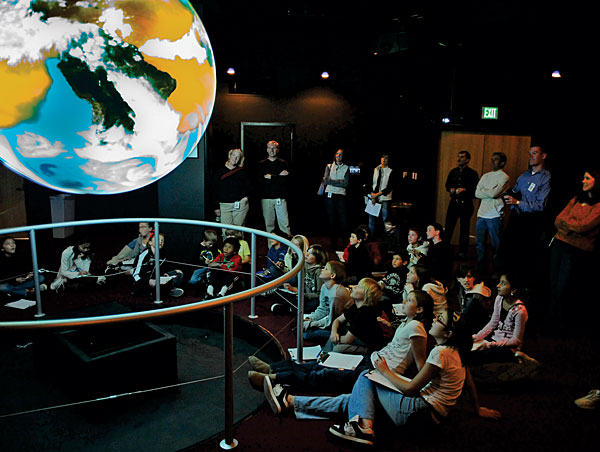“Science on a Sphere” has a global reach
DOI: 10.1063/PT.3.2241
At its Silver Spring, Maryland, headquarters in November, the National Oceanic and Atmospheric Administration opened the 100th installation of its “Science on a Sphere”: a 1.7-meter-diameter globe on which more than 400 annotated three-dimensional animations of Earth or other celestial bodies can be projected. Through the use of computers and four video projectors, the system displays global data sets that range from real-time weather satellite imagery and climate models to ocean temperatures and currents, the propagation of tsunamis, and even the paths of all airplane flights over a 24-hour period.

Students take in a global visualization on “Science on a Sphere” at the National Oceanic and Atmospheric Administration’s Earth System Research Laboratory in Boulder, Colorado. More than 100 of the spheres are now in operation worldwide.
WILL VON DAUSTER/NOAA

Identical spheres are located in 15 countries, including Mexico, which has 15, and China, which has 6. Most are housed in museums and aquariums, although a handful are located in NASA and NOAA facilities. Inventor Sandy MacDonald, director of NOAA’s Earth System Research Laboratory in Boulder, Colorado, says that in addition to their educational role, the spheres can help scientists visualize phenomena that aren’t apparent in a flat format. He cites as an example the Madden–Julian oscillation, a large-scale coupling between atmospheric circulation and tropical convection. “What you see along the equator are all these thunderstorms popping up and they look random, and when we put it on the sphere you can actually see these things move along the equator, taking as long as two to three months to go all the way around the Earth,” he says. “Until you see and can watch the whole Earth, you can’t really get a feeling for how that works.”
One data set of particular interest to physicists, MacDonald says, is from the Wilkinson Microwave Anisotropy Probe, the NASA spacecraft that produced full-sky maps of the fine-scale variations in the distribution of cosmic microwave background radiation from the Big Bang. (See Physics Today, April 2003, page 21
Louisa Koch, NOAA’s director of education, hopes that more universities will acquire spheres, which cost around $190 000 each, including installation. Earth scientists, geographers, geologists, and other scientists who work with spherical objects would likely find the globes useful in their research, she says. With museums, her office finds it a challenge to train docents to be conversant with a large number of the data sets. Although museums often use a narrated auto-run feature, Koch notes that a personalized presentation and question-and-answer session offer a more powerful educational experience.
“I’ve had kids come to me and say, ‘I was not that interested in science, but seeing the ocean currents and everything … ,’” says MacDonald. “We’re assaulted with all kinds of visual stuff every day, and it’s hard for scientific concepts to compete in that environment. You do have to have a bit of a wow factor.”
More about the Authors
David Kramer. dkramer@aip.org
